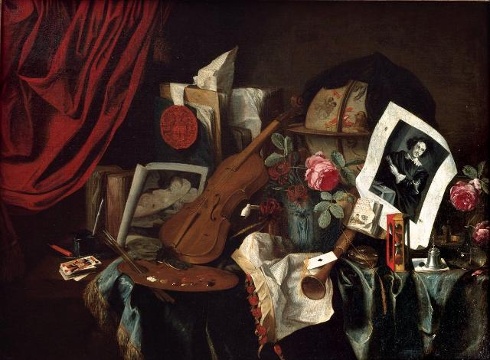News:
Cummer Museum settles Nazi-looting claim; Painting to stay in Jacksonville
By Steve Patrick

Vanitas, 1677, oil on canvas, by Dutch artist Jacques De Claeuw
Jacksonville, FL. - Almost 70 years after World War II ended, the Cummer Museum of Art & Gardens announced the amicable resolution of a claim regarding Nazi-era looting of a painting the museum purchased in 1962.
In 2012, The Cummer received notice from the heir of noted Jewish art dealer, Jacques Goudstikker, regarding a claim to a still life painting by 17th Century Dutch artist Jacques de Claeuw. After extensive research, both parties reached a settlement in the case which will result in the painting, Vanitas, remaining in Jacksonville.
“It is with great pleasure that The Cummer announces this amicable settlement,” Museum Director Hope McMath said. “We are delighted that, thanks to the generosity of Goudstikker’s family, this important painting will stay at The Cummer.”
In May 1940, Goudstikker, one of the foremost Old Master paintings dealers in the Netherlands, fled with his family by sea in advance of the Nazi invasion. Goudstikker died in an accident on board ship, but his family reached safety, maintaining possession of an inventory log that noted most of the nearly 1,400 artworks he had left behind.
Reichsmarschall Hermann Göring, a leading member of the Nazi party, looted the Goudstikker gallery holdings within weeks of the family fleeing. Extensive documentation exists tracing de Claeuw’s Vanitas from Goudstikker’s gallery, through Göring, to a sale at Lempertz Auktion in Cologne in 1941. However, there is no clear indication of what happened to the painting following the unsuccessful sale at Lempertz until it was purchased by The Cummer from a New York gallery in 1962.
The painting has been on near continuous display since that time, and was voted by Cummer visitors as one of their “50 Favorites” in the permanent collection in 2011, as part of The Cummer’s 50th anniversary.
This April, The Cummer’s Board of Trustees voted to return ownership to Goudstikker’s heir, daughter-in-law, Marei von Saher. As part of the settlement agreement, The Cummer negotiated the purchase of the painting, which included a gift from the family of Jacques Goudstikker, in his memory.
“It is heartening to see museums like The Cummer do the right thing for Holocaust victims and their heirs. I am grateful to The Cummer for returning this painting to Jacques Goudstikker’s family,” Ms. von Saher said. “We hope that the restitution of this work will lead other museums to act just as responsibly when faced with the discovery of Nazi-looted art in their collections.”
From 1933 through the end of World War II in 1945, the Nazi regime systematically pillaged cultural property and artworks throughout continental Europe. Some of their loot was sold to fund Nazi-related activities; some became the property of senior party officials. Other pieces were destroyed.
After the war, tens of thousands of confiscated objects were recovered by the Allies -- recently dramitized in the movie "Monuments Men" -- but that was only a portion of the works stolen. Although efforts were made to return these objects to their rightful owners, many works of art never found their way home.
To this day, museums and individual collectors still struggle to verify the proper ownership of works of art that changed hands during these years.
Lawrence M. Kaye, an attorney at Herrick, Feinstein LLP who has represented the von Saher family for many years, praised Cummer's response to how these disputes can be resolved.
“The museum took the claim seriously, and that made it easier for the parties to work together to find an amicable resolution and keep this beautiful work of art in the museum’s collection,” Kaye said.
http://www.news4jax.com/entertainment/cummer-museum-settles-nazilooting-claim-painting-to-stay-in-jacksonville/26655672


